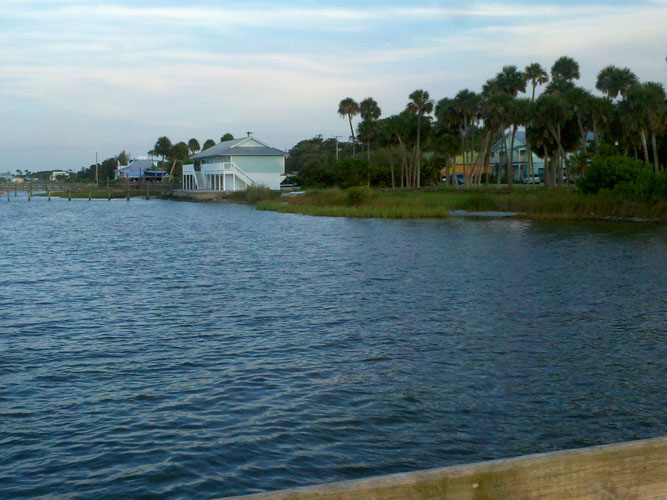
VERO BEACH — “The lagoon is dying and people are not aware of it,” says Rip Tosun, president of the Vero Beach Rotary Club. To raise awareness of impending ecological collapse in the waterway that is the economic and aesthetic centerpiece of Indian River County, island Rotarians will devote proceeds from their Nautical Flea Market to protecting seagrass on the Moorings Flats.
That 550-acre expanse of lush underwater meadow lies between the Moorings Channel in the north and Round Island Channel in the south, and between the shoreline and Intracoastal Waterway in the east and west.
Rotarian Paul Dritenbas, an architect and fishing guide, is leading an effort called RISSA – Rotary Initiative for Submerged Seagrass Awareness – that will surround the grass flats with a ring of buoys and warning signs to protect it from damage by powerboats.
“There are seven types of seagrass in the lagoon and all seven grow on the Mooring Flats,” says Dritenbas. “The area is an incredibly important nursery for marine life.”
Protecting the Moorings Flats, long a favorite fishing spot for Vero anglers, became critically important this year after all the seagrass north of the 17th Street causeway suddenly disappeared, taking away habitat and food for fish, manatees, bottlenose dolphins and hundreds of other species of marine life in the nation’s most biodiverse estuary.
A host of environmental stressors, from fertilizer and pesticide residue that runs off lawns to changing weather patterns, has hit the lagoon hard in the past several years.
Troy Rice, director of the Indian River Lagoon National Estuary Program, says last year’s extensive algae bloom, fed in part by fertilizer runoff, destroyed more than 30,000 acres of sea grass, 40 percent of the total in the northern lagoon.
“This is a crisis,” says Grant Gilmore, Ph.D., senior scientist with Estuarine, Coastal and Ocean Science, Inc. “Everyone should be concerned.”
Gilmore, one of the founding scientists at Harbor Branch Oceanographic Institute, wrote his doctoral dissertation on sea grass communities between Sebastian and Jupiter and is a leading expert on lagoon ecology.
“I first heard about the grass beds disappearing last winter,” Gilmore says. “A fisherman up in Sebastian called and told me the seagrass was gone.”
Since then, Gilmore has conducted four surveys between Grant and Vero Beach, checking areas of the lagoon where he knows seagrass has been abundant in the past, and found nothing but bare sand.
“There is no seagrass in that entire stretch, other than two tiny patches of shoal grass smaller than a desktop,” Gilmore says. “We have created a desert out there and it has happened very quickly.”
Gilmore says each acre of seagrass produces 10,000 fish annually, including sardines, anchovies and other small fry.
“Submersed Plants of the Indian River Lagoon,” a book published in 2008, puts the number even higher, at 100,000 fish per hectare, or 1.6 acres.
Either way, the loss of thousands of acres of grass in the stretch Gilmore surveyed means millions fewer fish in the lagoon and coastal waters, along with the loss hundreds of millions of other creatures ranging from tiny invertebrates to large mammals.
“The pigfish depend on sea grass,” Gilmore says. “No sea grass, no pig fish. Pig fish is the favorite food of sea trout. And sea trout are the favorite food of bottlenose dolphins.”
Manatee grass, formerly the most abundant species of grass in the lagoon, is the primary diet of the West Indian manatee.
“If we lose that permanently, we lose our beloved manatees,” Gilmore says. “Seagrass beds are where most of the biodiversity is. If you lose the seagrass, you lose most of the species in the lagoon.”
The Moorings Flats appear to be protected from the mysterious devastation northward by the flushing action of seawater into and out of the Fort Pierce Inlet, a tidal cleansing that extends to the 17th Street bridge.
But the grass beds are still threatened by damage from props on motor boats that can rip scars in the meadow that take years to heal.
Seagrass requires sunlight to grow and favors shallow water. Boaters who are unaware of the depth beneath them can unintentionally destroy precious habitat when cruising across the meadows.
The RISSA buoys are intended to alert boaters to shallow water and direct them around the edge of the meadow if they are in transit. Boats and fisherman will still be able to go onto the flats but will be aware of the danger their props pose to the environment.
RISSA will cost $18,500 to implement, according to Dritenbas. It will be funded by $7,000 from Vero Beach Rotary Club Nautical Flea Market proceeds, $2,000 from the Sunrise Rotary Club where Dritenbas is president, and a matching grant from FIND – Florida Inland Navigation District – which Commissioner Peter O’Bryan is pursuing.
“I do support [RISSA] and plan to bring it to the board, probably at an October meeting,” O’Bryan said in an e-mail. “I have sent the proposal to Bruce Barkett, our local FIND representative, for his and FIND staff review. Once I hear back from Bruce, I’ll put it on the board’s agenda.”
The biggest part of the cost – $10,220 – will go to pay for 28 highly durable can buoys that will be permanently moored around the perimeter of the grass flats and are expected to last for decades.
Buoys will be precisely located at GPS coordinates so if one ever tears loose in a storm it can be re-moored in the exact same location.
The flea market will be held Saturday and Sunday, Nov. 17 and 18, from 9 a.m. until 5 p.m. Club members say more than 60 venders have signed up so far, all dealing in marine-related goods.
“We think the flea market will give the lagoon’s problems high visibility with all the sailors and fishermen around, in addition to raising money for seagrass protection,” says island resident Wayne Wardwell.



